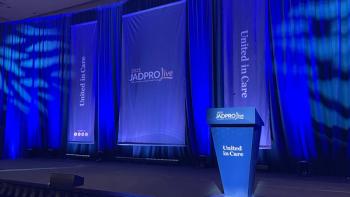
- February 2014
- Volume 8
- Issue 1
Select Older Patients Can Avoid Radiation After Breast-Conserving Surgery
A subgroup of older breast cancer patients may be able to forgo radiation therapy (RT) after breast-conserving surgery if they are treated with hormonal therapy and considered to be at low risk for breast cancer recurrence
Photo Courtesy © SABCS/Todd Buchanan 2013
Ian Kunkler, FRCR
A subgroup of older breast cancer patients may be able to forgo radiation therapy (RT) after breast-conserving surgery if they are treated with hormonal therapy and considered to be at low risk for breast cancer recurrence, according to results from the international phase III PRIME 2 trial presented at SABCS 2013. Abstract S2-01
The findings apply to women aged ≥65 years with hormone receptor-positive, axillary node-negative breast cancer. The PRIME 2 trial results were even more compelling in women with high estrogen receptor (ER) expression versus low ER expression.
“Radiotherapy has been known to reduce the risk of breast cancer recurrence three- to fourfold. However, our trial has shown that although this is the case, the proportion of women who actually will have a recurrence without radiotherapy is very small (<5%) 5 years after treatment,” said Ian Kunkler, FRCR, professor of clinical oncology, Edinburgh Cancer Research Center, University of Edinburgh, Scotland. “We have identified a subgroup of older patients at sufficiently low risk of recurrence for whom omission of postoperative radiotherapy after breast-conserving surgery and adjuvant endocrine therapy is a reasonable option.”
PRIME 2 randomized 1326 patients aged 65 or older with hormone receptor-positive, node-negative, T1-2 breast cancer (up to 3 cm) to receive adjuvant RT or none. All patients had clear surgical margins of at least 1 mm, and were receiving adjuvant endocrine therapy. Either grade 3 tumors or lymphovascular invasion was allowed, but not both.
Although the difference in 5-year ipsilateral breast tumor recurrence favored RT (26 patients [4.1%] had recurrence with no RT versus 6 [1.3%] who received RT, the absolute difference was very small. Five-year overall survival was 93.8% with no RT versus 94.2% in patients who received RT.
Investigators also examined the effect of ER-status on local recurrence. The local recurrence rate in patients whose tumors had high ER expression was 3.2% with no RT versus 0.8% with it; low ER expression was associated with an 11.1% recurrence rate without RT and 0% with RT.
Of 89 deaths across both groups, the majority (73%) were not linked to breast cancer. Of the 12 deaths attributed to breast cancer, four patients received postoperative RT and eight did not.
These results suggest that postoperative wholebreast radiation can be safely omitted in women aged 65 years or older with node-negative breast cancer and tumors up to 3 cm, Kunkler said. He added that forgoing radiation is especially reasonable in women whose tumors have high ER expression.
“For every 100 women [from our selected population] treated with radiotherapy, one will have a recurrence anyway, four will have a recurrence prevented, but 95 will have had unnecessary radiotherapy,” Kunkler explained. “Once a patient has radiotherapy, she is unable to have it again on the same breast. If these women had not had radiotherapy, they would have been able to have minor surgery and radiotherapy at recurrence. Besides, radiotherapy has its own health risks, particularly in the elderly, as well as the inconvenience of travel for daily treatment over 3 or 4 weeks.”
Nurse Perspective
David Leos, RN, MBA, OCN
Clinical Research Nurse Supervisor
Department of Radiation Oncology
UT MD Anderson Cancer Center
Houston, TX
This article provides evidence to further the concept that in terms of treatment options, less can be more. For this disease population, the study is reminiscent of the seminal National Surgical Adjuvant Breast and Bowel Project (NSABP) trials that proved lumpectomy plus radiation a viable treatment option over radical mastectomy. It also brings to mind an earlier review I did regarding the results of a study showing that shortening androgen blockade did not adversely affect certain prostate cancer outcomes.
As the literature presents additional such findings, media coverage counters with the double-whammy of limitations in access to healthcare coupled with spiraling costs. These results provide some solace that at least in some realms of oncology care, treatment needs could be shrinking.
For this subset of patients and for their care providers, this should be welcome news as it would add some flexibility and mitigation of potential risks in their long-term treatment approach by virtue of being able to hold in reserve the radiation treatment card.
When coupled with recent literature pointing out the association of comorbidities with poorer outcomes in cancer patient populations, these findings gain more merit (Clin Epidemiol. 2013;5[suppl 1]:3-29). Comorbidities are frequently associated with an advanced-age population like the patients enrolled in this study. Therefore, having the option to hold off on additional treatment, shown in this study not to adversely affect overall survival and recurrence rates, would seem prudent and in service of the patient’s interests.
From an economic perspective, instances when insurance approval allows for greater treatment utilization could potentially lead to moral hazard. This is the disassociation of personal harm from risks taken when all or some of the cost is carried elsewhere. Therefore, not needing to automatically undergo radiation treatment could limit personal risk while also serving as a judicious step in overall healthcare resource allocations.
Articles in this issue
over 11 years ago
Latest Data Further Support Ibrutinib's Efficacy in CLLover 11 years ago
Behind the Numbers: HPV Vaccination Is Highly Effectiveover 11 years ago
Strategies to Help Patients Adhere to Oral Cancer MedicationsNewsletter
Knowledge is power. Don’t miss the most recent breakthroughs in cancer care.





















































































